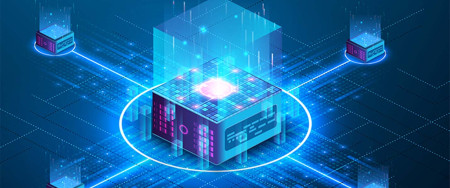Blockchain development is making waves across industries. It offers transparency and eliminates the need for a middleman. What does this mean for traditional sectors? The blockchain provides an immutable ledger that permanently records transactions between two parties without using a third party or intermediary, such as banks. Transactions are validated by consensus algorithms that ensure only one block can be added at any time to the chain, which cannot be altered retroactively without invalidating all following blocks.
Blockchain development is a type of software development. Just like there is a software development company that focuses on software development, blockchain becomes the sole focus of a blockchain development company.
It's being used across industries to make life easier for consumers, business owners, and those who want to do good in the world.
Blockchain development is creating decentralized digital ledgers that can be used for secure and transparent transactions. A blockchain is a distributed database that maintains a continuously growing list of records called blocks. Each block contains a timestamp and a link to the previous block, creating a chain of blocks that cannot be altered without the network consensus.
Blockchain development companies use blockchain development to digitize information and store it in blocks across the internet. The product requires developers, but it acts as a great ROI. It offers transparency, eliminates the need for a middleman, and could have far-reaching implications for various industries.
Blockchain development involves several key elements
Consensus Mechanisms
There are various consensus mechanisms used in blockchain development, such as Proof-of-Work, Proof-of-Stake, and Delegated Proof-of-Stake. These mechanisms determine how nodes on the network reach a consensus on the validity of transactions and the addition of new blocks to the blockchain.
Smart Contracts
These contracts are hardcoded in the codes and executed by themselves. Because of its self-execution functionality, there is no requirement to establish trust between buyers and sellers.
Cryptography
Cryptography is used to ensure the security of the blockchain. Public-key cryptography is used to authenticate users and verify transactions, while cryptographic hash functions create secure digital signatures.
Distributed Network
A blockchain is a distributed network of nodes that work together to maintain the integrity of the blockchain. Each node has a copy of the entire blockchain, making manipulating the data difficult for any single node.
User Interface
Blockchain development involves creating user interfaces that allow users to interact with the blockchain. These interfaces may include web applications, mobile applications, or command-line interfaces.
Blockchain development involves various technical skills, including software development, cryptography, networking, and distributed systems. It can potentially revolutionize industries from finance to healthcare by providing secure and transparent procedures for storing and sharing data.
In healthcare alone, blockchain has the potential to change the face of health records by providing better security for them and making them more accessible with one patient'spatient's data on all their devices.
Blockchain development demands much more than just a few programming skills. Blockchain developers should have knowledge and working proficiency in various tech stacks. Let'sLet's discuss a few of them here.
Ethereum
Ethereum is a cryptocurrency and blockchain framework that facilitates intelligent contracts. Ethereum is old, too; it was introduced back in 2013. The coins are called Ether (ETH). Ether has had a massive surge this year, climbing from USD 8 to over USD 800 within just one year. Investors who got into the currency early on have seen tremendous returns. It's currently at an all-time high of about $900 per coin, with an outstanding market cap of about 10 billion dollars.
Ethereum was first developed by a programmer called Vitalik Buterin when he came up with an idea to build a 'decentralized platform that runs smart contracts'. He then created a whitepaper describing how this would work and also created Ethereum's programming.
But the best part of EVM, also known as Ethereum Virtual Machine.
Ethereum Virtual Machine, or EVM for short, is the engine that drives Ethereum. It's a runtime environment that executes scripts using an international network of public nodes. The scripting language used by EVM is called Solidity. It allows you to create decentralized apps in multiple fields ranging from finance to healthcare and, more importantly, can automate business processes with smart contracts on the blockchain. This reduces costs associated with intermediaries like escrow agents and notaries while speeding up transactions.
Hyperledger fabric
In recent years, the world has been increasingly interested in cryptocurrencies. The current trend is for blockchain-based currencies to take over as they offer lower transaction costs and faster processing speeds than traditional fiat currencies. However, many are decentralized networks with no central authority or regulation. In response to this concern, easily save yourself from these issues and create enterprise-grade system companies to build blockchains that provide high levels of data privacy while also being able to be plugged into a modular architecture.
Hyperledger Fabric is a group of tools used to create blockchain applications. Its foundation is based on Linux, and it can be plugged into a modular architecture so that you can use only those parts of Hyperledger Fabric.
The best part about Hyperledger Fabric is its data privacy and high-speed transaction.
Hyperledger sawtooth
Hyperledger Sawtooth is an open-source, distributed ledger project which includes a consensus mechanism to maintain data integrity and reach network agreement on the state of transactions. Hyperledger Sawtooth can be used as an enterprise blockchain solution or in large networks, such as supply chains that require interoperability with legacy systems.
Hyperledger sawtooth, another framework, is also supported by Linux. It is open source and integrates hardware-based security tech to run secure enclaves.
This provides additional security for data storage in untrusted environments.
R3 Corda
R3 Corda is a blockchain-inspired software created to be faster and more secure than its competitors. In addition, the speed of the transactions can improve performance compared to other frameworks, like Ethereum.
The technology of R3 Corda has been developed by the financial services company, which is a blockchain-inspired distributed ledger. The best benefit of this framework is that all transactions are in real-time and can be used to boost performance when we compare it to other frameworks.
R3 Corda is said to be blockchain while not completely blockchain. Its best benefit is that all transactions are in real-time, which can be used to boost performance when we pit it against other frameworks.
Tesoz
The Tezos blockchain is a pretty old platform, as it was released in 2014. However, this does not mean that it is obsolete.
It was released initially as an ERC20 token on the Ethereum network, but it has since migrated to its native network.
It was released in 2014, which means it is not new by any stretch of the imagination, but it has evolved and changed so much since its release that it might as well be considered fresh. The platform offers plenty, such as supporting decentralized apps, smart contracts, and NFTs. In addition, they are upgrading rapidly - faster than most of their competitors - which should keep them on top for some time.
EOSIO
EOSIO is a blockchain-based platform that uses EOS tokens to power transactions. The token provides developers with the required resources for building and deploying decentralized applications, which can be used in social media, security, cloud storage, and games. EOSIO has been able to solve slow transactions because it doesn'tdoesn't have any fees when executing intelligent contracts or making public addresses accessible. In addition, EOSIO uses Delegated Proof of Stake (DPoS) to allow for speedy block production and confirmation time, with one block produced every 0.5 seconds on average. It's still being developed, but it's gaining popularity among developers because of its versatility and speed.
Conclusion
Blockchain is the latest technology that many companies are trying to grasp. However, there are many challenges when developing blockchain technology. They have been faced by major players such as IBM, JPMorgan Chase & Co., Intel Corp., and Microsoft Corp. But what if you hire blockchain developers? You can easily save yourself from these issues and create an enterprise-grade system. With the help of your engaged team, you'll be able to avoid all these difficulties without any hassle!
You see it in the news, on your favourite social media site, and in all sorts of advertisements. But when you look at these companies using blockchain to change how we do business, you can't help but wonder: 'How did they develop this amazing technology?' The answer is simple- They hired blockchain developers!
















